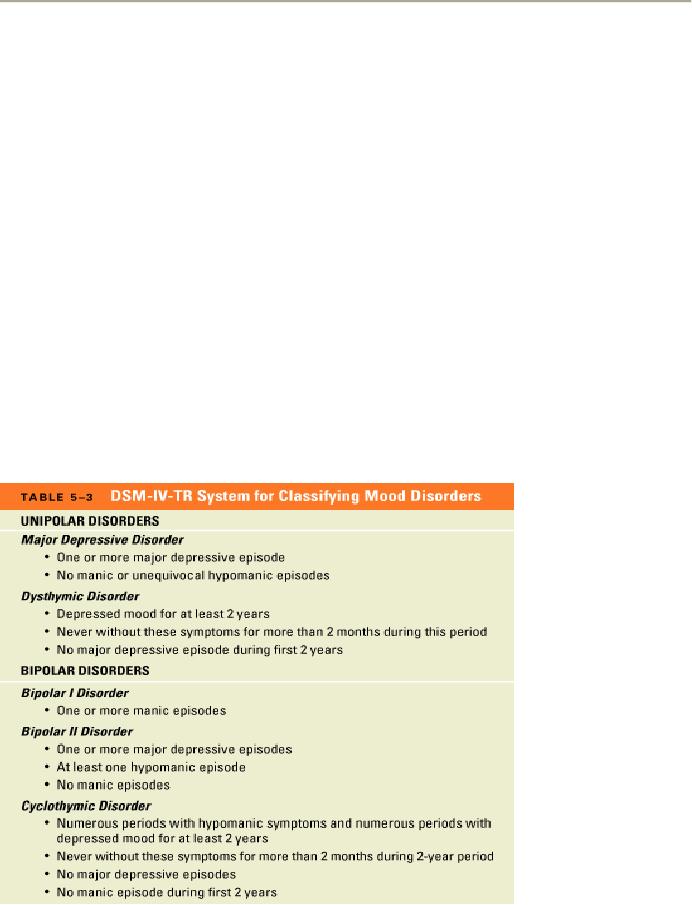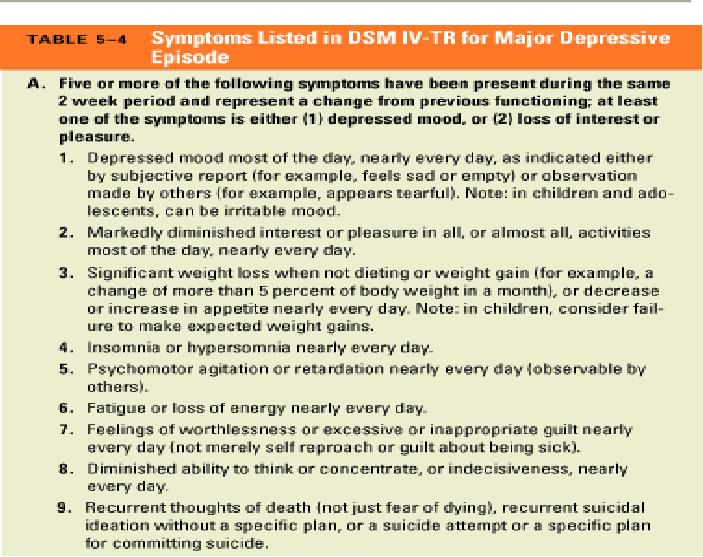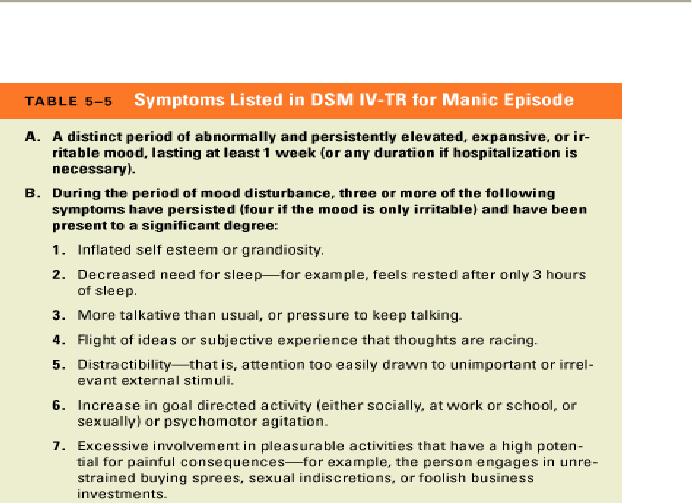 |
Abnormal
Psychology PSY404
VU
LESSON
26
MOOD
DISORDERS
�
MOOD
DISORDERS are the most common
psychological disorders and the risk of
developing
them
is increasing all over the
world especially among the young
people.
�
It is
really something which
scares us.
�
Mood
or affective disorders are syndromes of
depressions or a combination of
depression and
mania.
�
Normal
mood depression which last
for a few moments or
hours.
�
In
depression there is altered
energy level, motivation, behavior,
bodily functioning
�
Modification
in sleep and eating
patterns
�
When
these symptoms persist they
greatly impair individual's
ability
�
At
work and at home and
relationships at both places.
�
Unipolar
depression
�
Bipolar
depressions
Depression
is one of the most prevalent of all
clinical disorders co-occurring with
other medical and
psychological
disorders.
�
I
have missed placed my
important documents I am
sad
�
My
car has been stolen I am
pretty sad
�
My
purse has been snatched
with all my money I am
sad
�
My
student has lost her father
in death she refuses to come
to college
�
All
these are events which
make an individual become
sad but after some time we
get over them
and
move on.
�
You
do not encounter any such event
but you are sad
most of the day, irritable,
tired, your appetite
and
sleep patterns are irregular so
you suffer from mood
disorder.
�
What
is depression?
�
A
mood state.
�
Why do we
get depress?
�
We
think we are the only ones
with this disorder
�
What
are the symptoms of
depression?
�
Emotional,
cognitive and behavioral
�
Give
me one symptom of depression
observed in most people
�
Being
isolated
�
Alone
�
Seclusion.
�
Major
depression is the leading cause of
disability worldwide.
�
Emotion
refers
subjective states of feeling, such as
sadness, anger, and
disgust.
�
Affect
refers
to the pattern of observable behaviors,
such as facial expression,
that are associated
with
these subjective
feelings.
�
Mood
refers
to a pervasive and sustained
emotional response that, in its
extreme form, can
color
the
person's perception of the world.
�
Depression
can refer either to a mood or to a clinical
syndrome, a combination of
emotional,
cognitive,
and behavioral symptoms.
�
The
feelings associated with a
depressed mood often include
disappointment and despair.
�
Although
sadness is a universal experience,
profound depression is
not.
�
In the
syndrome of depression, which is
also called clinical
depression, a
depressed mood is
accompanied
by symptoms, such as
�
fatigue,
�
loss
of energy,
�
difficulty
in sleeping, and
�
changes
in appetite.
121
Abnormal
Psychology PSY404
VU
�
Mania,
the
flip side of depression,
also involves a disturbance in
mood that is
accompanied
by additional symptoms.
�
Mania
is an elated mood, is the opposite
emotional state from a
depressed mood.
�
It is
characterized by an exaggerated feeling of
physical and emotional
well-being.
�
Manic
symptoms that frequently
accompany an elated mood
include
�
inflated
self-esteem,
�
decreased
need for sleep,
�
distractibility,
�
pressure
to keep talking, and
�
the
subjective feeling of thoughts racing
through the person's head
faster than
they
can be spoken.
�
Mood
disorders are
defined in terms of episodes--discrete
periods of time in which the
person's
behavior
is dominated by either a depressed or manic
mood.
�
Unipolar
mood disorder is a
mood disorder in which the person
experiences only episodes
of
depression.
�
Bipolar
mood disorder is a
mood disorder in which the person
experiences episodes of mania
as
well
as depression.
�
Years
ago, bipolar mood disorder
was known as manicdepressive
disorder.
�
Although
this term has been replaced in the
official diagnostic manual,
some clinicians still
prefer
to
use it because it offers a more direct
description of the patient's experience.
Important
Considerations in Distinguishing Clinical
Depression from Normal
Sadness
1.
The mood change is pervasive
across situations and
persistent over time.
2.
The mood change may
occur in the absence of any
precipitating events, or it may be
completely out
of
proportion to the person's
circumstances.
3.
The depressed mood is
accompanied by impaired ability to
function in usual social
and
occupational
roles.
4.
The change in mood is
accompanied by a cluster of additional
signs and symptoms,
including
cognitive,
somatic, and behavioral
features.
5.
The nature or quality of the
mood change may be different
from that associated with
normal
sadness.
Emotional
Symptoms
�
Depressed,
or dysphonic
(unpleasant),
mood is the most common and
obvious symptom of
depression.
�
In
contrast to the unpleasant feelings
associated with clinical depression,
manic patients
experience
periods
of inexplicable and unbounded joy
known as euphoria.
�
Many
depressed and manic patients
are irritable.
�
Anxiety
is also common among people with
mood disorders, just as
depression is a common
feature
of some anxiety disorders.
Cognitive
Symptoms
�
People
who are clinically depressed
frequently note that their
thinking is slowed down,
that they
have
trouble concentrating, and that they
are easily
distracted.
�
Guilt
and worthlessness are common
preoccupations.
�
They
focus considerable attention on the
most negative features of
themselves, their environments,
and
the future--a combination known as the
"depressive triad."
�
In
contrast to the cognitive slowness
associated with depression,
manic patients commonly
report
that
their thoughts are speeded
up.
�
Manic
patients can also be easily
distracted, responding to seemingly random
stimuli in a
completely
uninterpretable and incoherent fashion.
122
Abnormal
Psychology PSY404
VU
�
Inflated
self esteem is also
characteristic features of
mania.
�
Many
people experience self-destructive ideas
and impulses when they are
depressed.
�
Interest
in suicide usually develops
gradually and may begin with
the vague sense that life is
not
worth
living.
Somatic
Symptoms
�
The
somatic
symptoms of
mood disorders are related
to basic physiological or bodily
functions.
�
They
include fatigue, aches and pains,
and serious changes in appetite
and sleep patterns.
�
Trouble
getting to sleep is
common.
�
In the
midst of a manic episode, a
person is likely to experience a
drastic reduction in the need
for
sleep.
�
Although
some depressed patients
report that they eat more
than usual, most reduce the
amount
that
they eat; some may eat
next to nothing.
�
People
who are severely depressed
commonly lose their interest in
various types of activities
that
are
otherwise sources of pleasure
and fulfillment.
�
Some
patients complain of frequent headaches
and muscular aches and
pains.
Behavioral
Symptoms
�
The
symptoms of mood disorders
also include changes in the things that
people do and the rate at
which
they do them.
�
The
term psychomotor
retardation refers
to several features of behavior
that may accompany
the
onset
of serious depression.
�
The
most obvious behavioral symptom of
depression is slowed
movement.
�
Patients
may walk and talk as if they
are in slow motion.
�
Others
become completely immobile and
may stop speaking
altogether.
�
Some
depressed patients pause for
much extended periods,
perhaps several minutes,
before
answering
a question.
�
In
marked contrast to periods when they
are depressed, manic
patients are typically
gregarious and
energetic.
Other
Problems Commonly Associated with
Depression
�
Within
the field of psychopathology, the simultaneous
manifestation of a mood disorder and
other
syndromes
is referred to as comorbidity, suggesting
that the person exhibits symptoms of
more
than
one underlying disorder.
�
Alcoholism
and depression are clearly
related phenomena.
�
Eating
disorders and anxiety disorders
are also more common among
first-degree relatives of
depressed
patients than among people in the
general population.
Brief
Historical Perspective
�
The
first widely accepted classification
system was proposed by the German
physician Emil
Kraepelin.
�
Kraepelin
divided the major forms of mental disorder
into two categories:
dementia
praecox, which
we
now know as schizophrenia,
and manicdepressive
psychosis.
�
He
based the distinction on age of
onset, clinical symptoms, and the
course of the disorder (its
progress
over time).
�
The
manicdepressive category included
all depressive syndromes,
regardless of whether the
patients
exhibited manic and
depressive episodes or simply
depression.
�
In
comparison to dementia praecox,
manicdepression typically showed an
episodic, recurrent
course
with a relatively good
prognosis.
123

Abnormal
Psychology PSY404
VU
�
Despite
the widespread acceptance and influence
of Kraepelin's diagnostic system, many
alternative
approaches
have been proposed.
�
Two
primary issues have been
central in the debate regarding
definitions of mood
disorders.
�
First,
should these disorders be defined in a
broad or a narrow fashion?
�
A
narrow approach to the definition of
depression would focus on the
most severely disturbed
people--those
whose depressed mood is
entirely pervasive and
associated with a wide range
of
additional
symptoms.
�
A
broader approach to definition would
include mild depression, which
lies somewhere on the
continuum
between normal sadness and
major depression.
�
The
second issue concerns
heterogeneity.
�
All
depressed patients do not
have exactly the same set of
symptoms, the same pattern of onset,
or
the
same course over
time.
�
Are
there qualitatively distinct forms of
mood disorder, or are there
different expressions of the
same
underlying problem?
�
Is
the distinction among the different
types simply one of
severity?
Contemporary
Diagnostic Systems
�
The
DSM-IV-TR approach to classify
mood disorders recognizes
several subtypes of
depression,
placing
special emphasis on the distinction
between unipolar and bipolar
disorders.
�
The
overall scheme includes two
types of unipolar mood disorder
and three types of bipolar
mood
disorder.
Unipolar
Disorders
�
The
unipolar disorders include two
specific types: major depressive disorder
and dysthymia.
�
In
order to meet the criteria for major
depressive disorder, a person must
experience at least
one
major
depressive episode in the absence of
any history of manic
episodes.
124

Abnormal
Psychology PSY404
VU
�
Dysthymia
differs
from major depression in terms of
both severity and
duration.
�
Dysthymia
represents a chronic mild depressive
condition that has been
present for many
years.
�
In
order to fulfill DSM-IV-TR criteria
for this disorder, the person must,
over a period of at least
2
years,
exhibit a depressed mood for
most of the day on more days
than not.
�
Two
or more of the following symptoms
must also be present for a
diagnosis of dysthymia:
1.
Poor appetite or overeating
2.
Insomnia or hypersomnia
3.
Low energy or fatigue
4.
Low self-esteem
5.
Poor concentration or difficulty making
decisions
6.
Feelings of hopelessness
�
The
distinction between major depressive
disorder and dysthymia is somewhat
artificial because
both
sets of symptoms are
frequently seen in the same
person.
�
In
such cases, rather than
thinking of them as separate disorders,
it is more appropriate to consider
them
as two aspects of the same disorder,
which waxes and wanes
over time.
Bipolar
Disorders
�
All
three types of bipolar
disorders involve manic or hypomanic
episodes.
�
The
mood disturbance must be
severe enough to interfere with
occupational or social
functioning.
125

Abnormal
Psychology PSY404
VU
�
A
person who has experienced
at least one manic episode
would be assigned a diagnosis of
bipolar
I
disorder.
�
To
be fully discussed in lecture no
27.
126
Table of Contents:
- ABNORMAL PSYCHOLOGY:PSYCHOSIS, Team approach in psychology
- WHAT IS ABNORMAL BEHAVIOR:Dysfunction, Distress, Danger
- PSYCHOPATHOLOGY IN HISTORICAL CONTEXT:Supernatural Model, Biological Model
- PSYCHOPATHOLOGY IN HISTORICAL CONTEXT:Free association, Dream analysis
- PSYCHOPATHOLOGY IN HISTORICAL CONTEXT:Humanistic Model, Classical Conditioning
- RESEARCH METHODS:To Read Research, To Evaluate Research, To increase marketability
- RESEARCH DESIGNS:Types of Variables, Confounding variables or extraneous
- EXPERIMENTAL REASEARCH DESIGNS:Control Groups, Placebo Control Groups
- GENETICS:Adoption Studies, Twin Studies, Sequential Design, Follow back studies
- RESEARCH ETHICS:Approval for the research project, Risk, Consent
- CAUSES OF ABNORMAL BEHAVIOR:Biological Dimensions
- THE STRUCTURE OF BRAIN:Peripheral Nervous System, Psychoanalytic Model
- CAUSES OF PSYCHOPATHOLOGY:Biomedical Model, Humanistic model
- CAUSES OF ABNORMAL BEHAVIOR ETIOLOGICAL FACTORS OF ABNORMALITY
- CLASSIFICATION AND ASSESSMENT:Reliability, Test retest, Split Half
- DIAGNOSING PSYCHOLOGICAL DISORDERS:The categorical approach, Prototypical approach
- EVALUATING SYSTEMS:Basic Issues in Assessment, Interviews
- ASSESSMENT of PERSONALITY:Advantages of MMPI-2, Intelligence Tests
- ASSESSMENT of PERSONALITY (2):Neuropsychological Tests, Biofeedback
- PSYCHOTHERAPY:Global Therapies, Individual therapy, Brief Historical Perspective
- PSYCHOTHERAPY:Problem based therapies, Gestalt therapy, Behavioral therapies
- PSYCHOTHERAPY:Ego Analysis, Psychodynamic Psychotherapy, Aversion Therapy
- PSYCHOTHERAPY:Humanistic Psychotherapy, Client-Centered Therapy, Gestalt therapy
- ANXIETY DISORDERS:THEORIES ABOUT ANXIETY DISORDERS
- ANXIETY DISORDERS:Social Phobias, Agoraphobia, Treating Phobias
- MOOD DISORDERS:Emotional Symptoms, Cognitive Symptoms, Bipolar Disorders
- MOOD DISORDERS:DIAGNOSIS, Further Descriptions and Subtypes, Social Factors
- SUICIDE:PRECIPITATING FACTORS IN SUICIDE, VIEWS ON SUICIDE
- STRESS:Stress as a Life Event, Coping, Optimism, Health Behavior
- STRESS:Psychophysiological Responses to Stress, Health Behavior
- ACUTE AND POSTTRAUMATIC STRESS DISORDERS
- DISSOCIATIVE AND SOMATOFORM DISORDERS:DISSOCIATIVE DISORDERS
- DISSOCIATIVE and SOMATOFORM DISORDERS:SOMATOFORM DISORDERS
- PERSONALITY DISORDERS:Causes of Personality Disorders, Motive
- PERSONALITY DISORDERS:Paranoid Personality, Schizoid Personality, The Diagnosis
- ALCOHOLISM AND SUBSTANCE RELATED DISORDERS:Poly Drug Use
- ALCOHOLISM AND SUBSTANCE RELATED DISORDERS:Integrated Systems
- SCHIZOPHRENIA:Prodromal Phase, Residual Phase, Negative symptoms
- SCHIZOPHRENIA:Related Psychotic Disorders, Causes of Schizophrenia
- DEMENTIA DELIRIUM AND AMNESTIC DISORDERS:DELIRIUM, Causes of Delirium
- DEMENTIA DELIRIUM AND AMNESTIC DISORDERS:Amnesia
- MENTAL RETARDATION AND DEVELOPMENTAL DISORDERS
- MENTAL RETARDATION AND DEVELOPMENTAL DISORDERS
- PSYCHOLOGICAL PROBLEMS OF CHILDHOOD:Kinds of Internalizing Disorders
- LIFE CYCLE TRANSITIONS AND ADULT DEVELOPMENT:Aging